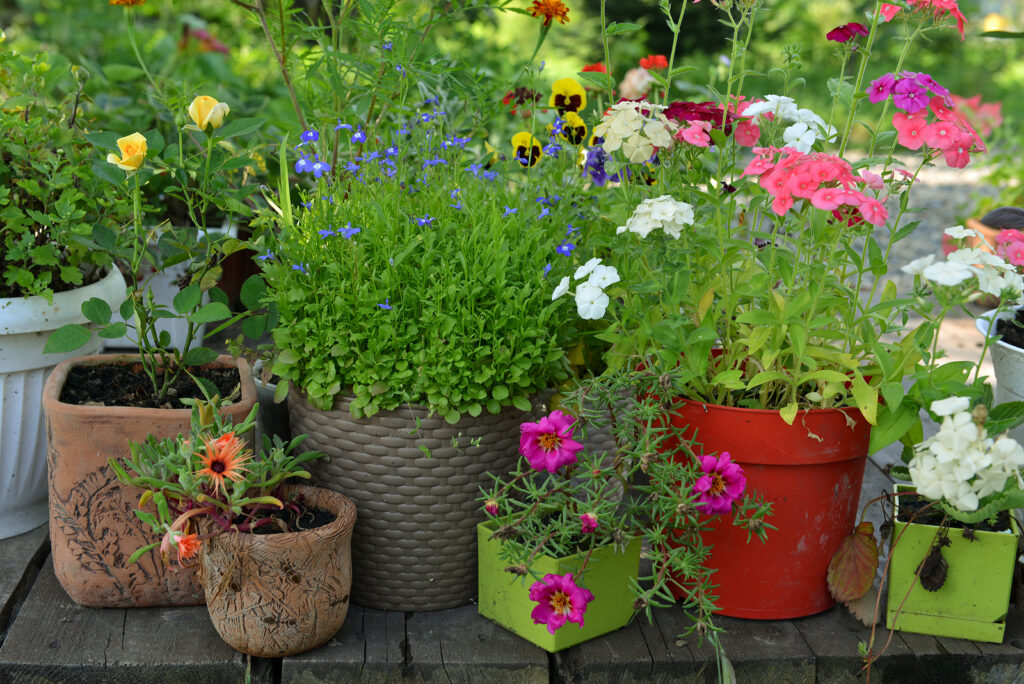Container gardening makes gardening portable. A container garden can be anywhere there is a bit of sunlight—on the front step of a cottage or on the balcony of a high rise.
Any plant can be grown in a container, and nearly any combination of plants can be grown in containers.
No matter what your budget, the scale of your location, or level of skill, you can create a container garden.
Here are a few things to keep in mind when thinking about growing in containers. At the end of this article are links to more tips on container gardening.

Container garden advantages
- Blossoms or a green oasis can be grown almost anywhere. Almost any kind of plant can be grown in a container.
- Container gardening allows for flexibility. Plants in containers can be placed exactly where you want them. Containers can be arranged, rearranged, and replaced at any time.
- A container planting can be a single pot or flowers or a full garden border of collected pots/
- The beauty and fragrance of plants can be brought close.
- Plants that are not cold-hardy can be brought indoors in winter.

Container material
Almost any container that is well-drained is suitable for growing plants: clay and ceramic pots, plastic and resin pots, metal buckets, wooden boxes, baskets—any container that can hold soil and will allow water to drain through. Here are the advantages and disadvantages of container material:
- Clay: unglazed terracotta is porous and allows air to plant roots; clay pots absorb water and may need frequent watering; the weight of clay can bring stability to top-heavy plantings; may break in freezing weather.
- Wood: usually lightweight; impervious to frost; can be painted; can rot if not treated; wood containers will be square or rectangular.
- Stone: strong and durable; nonporous so does not dry out quickly; usually heavy but stable.
- Metal: many are lightweight; frost-proof; prone to rust; may scratch or dent; metal can heat up—heat can damage plant roots.
- Synthetic: made from plastics, polymers, fiberglass, and resins; lightweight; frost-proof; can scratch and scuff; these may be the best choice if plants will be moved indoors and out in cold-winter regions.
- Light-colored pots are the best choice in hot climates; light colors will reflect heat and help keep roots cool. Black pots and metal pots are not a good choice in hot climates.

Container size and shape
- For best effect, choose containers and plants to be in scale with the location. A small space may call for small containers; a larger space will require large containers for the best effect.
- Choose a container that is to the scale of the plant or plants it will hold.
- Flowering annuals and perennials will need containers that contain 2 to 4 gallons (9-8L) of growing medium.
- Shrubs and small trees will need containers that contain will need 4 to 10-gallon containers or larger.
- As a general rule, bigger containers are usually better than smaller containers; there is room for root growth and plants will need repotting less frequently.
- Large containers 10 inches (25cm) in diameter is usually a good size for many flowering plants
- Large containers retain moisture rather than drying out quickly; they can make a strong impact. Large containers can be heavy; weight is a consideration if the container is on a balcony.
- Small containers can get lost when situated in the outdoors. Small containers usually have the best effect if they are grouped together. Grouping small containers make watering and maintenance easier.
- Small containers are easily moved but dry out quickly.
- Low containers are best for low, trailing plants.
- Tall containers are a good choice for tall plants.
- Vary the height and width of containers to create extra interest. Place small containers in front and larger containers in the back.
Container drainage
- A container for plants must have drainage holes. This is critical for root growth and top-growth.
- Holes should be at least ½ inch (12mm) in diameter.
- If you are creating your own containers, drill at least six holes in medium-sized containers and more in larger ones.
- Choose a saucer large enough that water can drain into the saucer without overflowing.
- If you use a container without drainage holes, place a few blocks of wood at the bottom of the container. This will lift plant roots above water that collects in the pot. This is less than ideal; over time the water level may rise in the pot causing roots to rot.
- An alternative if a pot has no drainage holes is to place a potted plant into a large container. Fill around the pot with soil or mulch to make it look as though the plant is planted in the larger container.

Where to place containers
- Container plants can be grouped to create a garden of their own.
- A single container plant can be located to create visual interest; treated much as a specimen plant in the garden.
- Plant in containers can be grouped to create a theme; a rose garden, an herb garden, a collection of trailing plants, or succulents.
- Two larger containers can flank a door or garden entrance.
- Small containers can line steps.
- Hanging baskets can add vertical color to a location.
- Container plants can create a focal point; they can create interest where a planting bed can’t be.
Also of interest:
Choosing Plants for a Container















